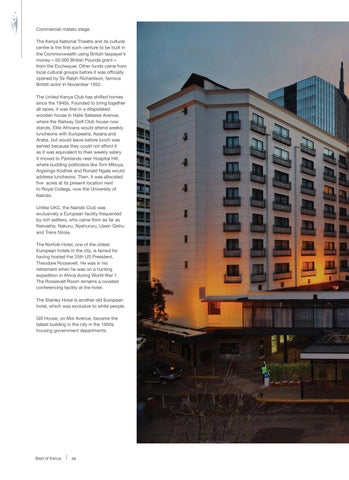Commercial matatu stage. The Kenya National Theatre and its cultural centre is the first such venture to be built in the Commonwealth using British taxpayer’s money – 50,000 British Pounds grant – from the Exchequer. Other funds came from local cultural groups before it was officially opened by Sir Ralph Richardson, famous British actor in November 1952. The United Kenya Club has shifted homes since the 1940s. Founded to bring together all races, it was first in a dilapidated wooden house in Haile Selassie Avenue, where the Railway Golf Club house now stands. Elite Africans would attend weekly luncheons with Europeans, Asians and Arabs, but would leave before lunch was served because they could not afford it as it was equivalent to their weekly salary. It moved to Parklands near Hospital Hill, where budding politicians like Tom Mboya, Argwings Kodhek and Ronald Ngala would address luncheons. Then, it was allocated five acres at its present location next to Royal College, now the University of Nairobi. Unlike UKC, the Nairobi Club was exclusively a European facility frequented by rich settlers, who came from as far as Naivasha, Nakuru, Nyahururu, Uasin Gishu and Trans Nzoia. The Norfolk Hotel, one of the oldest European hotels in the city, is famed for having hosted the 25th US President, Theodore Roosevelt. He was in his retirement when he was on a hunting expedition in Africa during World War 1. The Roosevelt Room remains a coveted conferencing facility at the hotel. The Stanley Hotel is another old European hotel, which was exclusive to white people. Gill House, on Moi Avenue, became the tallest building in the city in the 1950s housing government departments.
The Stanley Hotel
Best of Kenya
46
Best of Kenya
47
